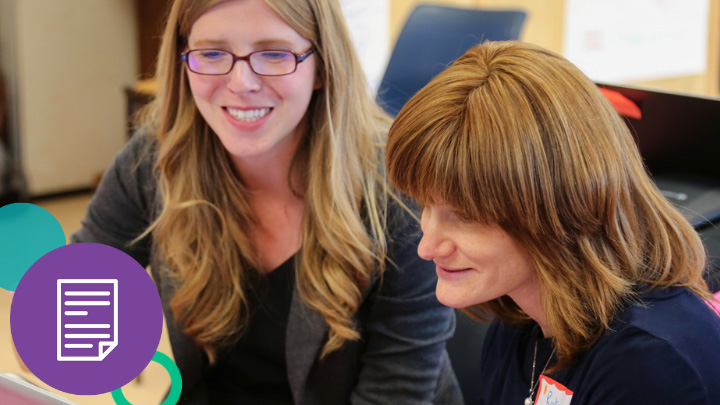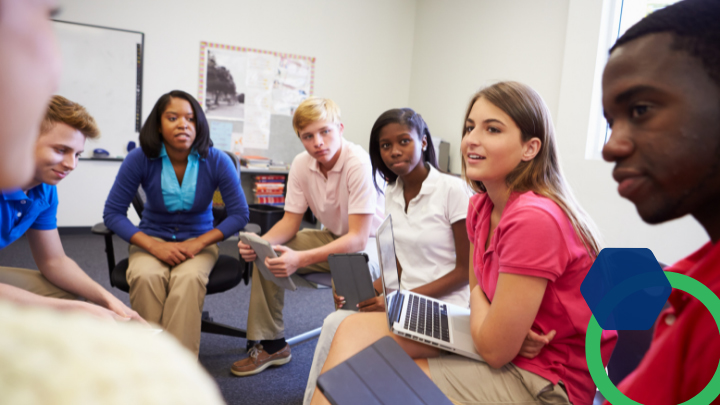As a secondary school special education and math teacher, my favorite moments were when I watched students look at a math problem, select a strategy, and implement that strategy. I didn’t much care if the first answer they got was right or wrong as long as I saw the mathematical mindset start to set in. I watched for students’ flexibility of thought and perseverance in the face of setbacks.
As a BetterLesson coach, my favorite moments are similar. I like the process of coaching teachers: working with educators to identify a challenge they want to address, thinking about the causes of that challenge, designing a strategy, implementing it, and iterating on our plan based on the results. I have seen that self-reflection and the courage to try new things are necessary for growth when working with both teachers and students. We as coaches have the responsibility of setting up the coaching relationship and environment in a way that allows teachers the time and space to be reflective and gives them the support needed to experiment with different pedagogical techniques and strategies.
When we transitioned to emergency distance learning in March, I worried that the sheer volume of work teachers had to do would leave them with less time to reflect on their practice and less willing to experiment. What I found instead was that teachers wanted to continue meeting regularly, some preferring to meet more frequently because they wanted support with figuring out how to juggle their massive new workload. Teachers who had previously been hesitant to identify their growth areas were able to pinpoint critical challenges they wanted to address in our meetings. Remote learning provided us with a new challenge and an opportunity to experiment with blended learning models. During this transition, the teachers I supported needed a space to discuss challenges, think creatively, plan for solutions, and reflect on the effectiveness of their efforts.
To ensure that my support reduced teacher workload, rather than adding to it, I focused on five core principles to guide my coaching, which works both in fully remote and hybrid environments.
1. Be consistent, yet flexible
Why? Teachers’ schedules and workload will feel more predictable and manageable.
COVID-19 has made it impossible to plan long-term which is incredibly frustrating for teachers. By holding expectations as consistent as we can, we can bring some predictability back and allow our teachers to plan around our workstreams and meetings. Coaches already strive to be as steady and consistent as we can, but it’s even more important now. There will likely be changes throughout this year as we adapt to constantly updating coronavirus regulations, so it’s important that we recognize what is in our control.
Coaching example
Natalie* and I struggled to find time to meet for the first half of the year. It made it hard for us to build rapport with each other and it was difficult to plan for our meetings as they were frequently canceled or scheduled very last minute. This led us to devalue our time together. On March 12th last year, I got an email from Natalie with several questions she wanted to discuss at our next meeting. In that meeting, we acknowledged that our coaching patterns were not ideal and that we needed to amp back up because of the transition to distance learning. We recommitted to a regular bi-weekly meeting time and agreed to protect that time at all costs. For the remainder of the year, we met bi-weekly. There were still moments when we had to reschedule or be flexible, but for the most part, committing to a time and sticking to it made it possible for us to engage meaningfully in planning for pedagogical shifts in her Zoom classroom.
2. Focus on one thing at a time
Why? Coaching will go deep on important issues, and you will see growth more quickly.
Prioritizing and working on one thing at a time can be incredibly challenging, especially in the midst of distance and hybrid learning. However, selecting just one key focus area at a time will ensure that meetings feel less overwhelming and more focused. Engaging in deeper discussion and giving more planning time to address one challenge at a time allows us to see progress faster, leading to an increase in teacher performance and satisfaction. At BetterLesson we use the Try-Measure-Learn coaching model with teachers and leaders to help us prioritize and track growth. Some examples of focus areas that have been crucial for teachers during this time are: connecting with disengaged students, providing support to families, and developing authentic assessments.
Coaching example
When I met with Joe* once school moved online, he had many competing priorities. He was thinking about how to engage students, address issues with access to technology, create materials, use synchronous time, and help students with asynchronous tasks in a sustainable way. Each challenge was important, so we narrowed our focus by identifying (1) what challenges were within his control or sphere of influence, and (2) what challenges felt most pressing or most important. We focused on embedding support into asynchronous materials so that students could complete assignments independently. He filmed a video with instructions for accessing and completing each assignment and prioritized finding assignments with self-grading and automatic feedback functions (like Google Forms Quizzes) so that students could check their work. By focusing on just one thing, we were able to make meaningful progress. Joe saw his time spent on the phone or email with students/parents each night decrease, leaving us more time to address his other challenges.
3. Encourage experimentation by normalizing failure
Why? Teachers will find solutions more quickly and will share ideas more openly.
In each coaching meeting since March, I have asked participants what their biggest goal/challenge/focus is and all have said something like “I want my students to be safe and to continue learning.” This means that teachers will need to try different methods to engage students, present content, and measure mastery. When experimenting, the possibility of failure can sometimes restrict what we are willing to try. It’s important that we emphasize for teachers that not everything will work for students but even failures give us good data. Consider using a routine like Debriefing and Setting Next Steps in coaching meetings to help teachers reflect on their current practice and plan to take thoughtful risks or using a protocol like Collegial Observations to work with them to evaluate the effectiveness of the strategies they’ve implemented.
Coaching example
A few weeks into April, Matt* was still struggling to get his students logged on to Zoom each day. He had only spoken to five students since the transition to distance learning and was worried about his class. He wanted to know that they were okay and wanted to keep them learning. He felt that if his students waited too long to start coming to class or start completing assignments they would experience huge summer slides. He tried calling and texting parents to remind them of Zoom class times. It was ineffective, so he knew he needed to try something else. First, we planned for him to reach out to families individually to arrange conference times so he could help parents set up a home routine around Zoom class and could ask parents for their thoughts on how he could improve engagement. He was only able to reach a few parents this way. We went back to the drawing board and realized that one reason Joe was struggling was that he hadn’t successfully built relationships with families yet. We realized that we went wrong in our planning by not pulling in other teachers or service providers that knew his family. Joe then tried joining the social worker on her calls to families. She had established positive relationships so was able to work with Joe and each family to set up an individual plan to get students engaged. Changes didn’t happen overnight and there were still some students he struggled to connect with, but our first failure led us to find something more effective.
4. Address staff members’ emotional needs through integrating mindfulness practices
Why? We will learn strategies that support our own emotional well-being so that we are able to be there for students.
Mindfulness strategies are not a cure-all for the stress produced by the public health emergencies of coronavirus and systemic racism and they cannot and should not replace seeking professional help. What mindfulness strategies can do is create time and space for calmness during hectic times and can re-center us when we are feeling overwhelmed, disconnected, anxious, or any of the other feelings accompanying this pandemic. Sharing these strategies with teachers and even using these strategies with teams can help us refocus ourselves and clarify what is truly important in the midst of uncertain times.
Coaching example
Viviana* and I were working on integrating mindfulness strategies into her synchronous sessions because she felt that students were high anxiety and needed emotional support. As part of our preparation for her to integrate this strategy, we decided to practice implementing mindfulness practices at the beginning of our meetings. We found that it slowed us down and allowed us to clear our heads of everything we were holding on to from our busy days before we got to work together. We spent a little bit more of our meetings talking about how we were doing, but we were better able to plan together because we understood each other. I find that I have to be more intentional with building relationships now that we are more distant from each other and have fewer social touchpoints with each other.
5. Support teachers in building/maintaining systems
Why? Teachers’ workloads will lessen, and students’ workloads will feel more predictable and manageable.
Because of how new distance and hybrid learning are to both schools and families, teachers are having to spend much more time completing tasks in every area of their work. In my coaching meetings with teachers, many have voiced that the following parts of their role are taking much more time than usual: responding to student/parent questions, planning engaging lessons and activities, providing technical support, assessing student growth, and giving meaningful feedback on student work. While we may not be able to decrease the number of questions students and families have or the number of assignments teachers have to assess, we can coach teachers by building a system in any of these areas that would save them time. If teachers are feeling overwhelmed across the board, they may first want to create a personal routine for their own time management. Consider working with teachers to create effective checklists.
Coaching example
To address the challenge of planning lessons and activities that would increase engagement in synchronous Zoom meetings in a sustainable way, Monique* and I created a weekly schedule in which she rotated through engagement ideas she could use in the first five minutes of Zoom to set a tone of positive participation at the very start of each class session. Once we built the system, she no longer had to come up with a plan for the beginning of each class period – she already had the structure designed and could plug in appropriate activities. On Mondays and Wednesdays, students did a social-emotional pulse check in Zoom to give her an idea of how they were starting the week. On Tuesdays and Thursdays, she gave students 5 minutes to look over their homework and type their answers to one of the questions in the chat. On Fridays, students reviewed their goals for the previous week and set goals for the week ahead. This level of predictability decreased Monique’s workload while also making the start of class more predictable and student-centered.
These principles are good coaching practices at any time, so it’s doubly important that we commit to them now while our teachers are facing ever-changing job expectations, are responsible for learning multiple new skills, and are expending substantial effort to engage students in an equitable way.
*Teacher names have been changed







